![]()
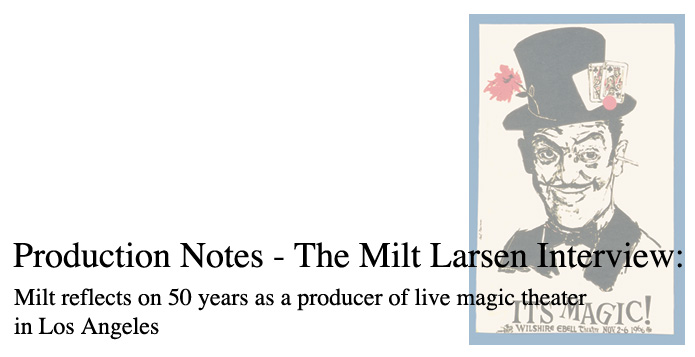
|
LAS VEGAS, February 2006 — We're in Las Vegas, in a room at the Orleans. The interview begins as Milt tosses a single playing card face down onto the coffee table. It's a red-backed card from a Magic Castle deck. "Name any card," he says. "Any card at all." "The eight of clubs," I respond. "Turn it over." If it's the eight of clubs, I am going to lose it right now. There is just no way. I turn the card over, and I lose it alright, but in laughter rather than surprise. On the card in bold black letters are the words "SORRY, I DON'T DO CARD TRICKS." Beneath the words are Milt's business info, identifying him as President of Magic Castles, Inc. and providing all his contact info, including the number of his booking agent. (Milt is still available for such special gigs as opening for Amazing Johnathan.) It's a revealing gag, as Milt really doesn't do card tricks. Magic to Milt has always been something performed up on a stage by a talented entertainer, with quality lighting and sound, with expert direction, with an orchestra in the pit, with professional stage sets, with pretty girls, and with comfortable seating for the audience. Ideally the show will feature a sequence of such entertainers, a perfect vaudeville blend of flash, comedy, manipulation, novelty, and illusions. For 50 years, Milt has treated southern California audiences to his idea of what magic should be, a span that has seen hundreds of top magic acts appear under the banner of Milt's flagship annual production, It's Magic!. It's a pleasure to sit with Milt and chat with him about his first 50 years as a Producer of magical theater. |
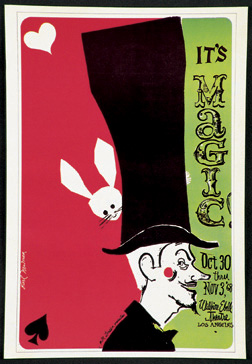 Earl Newman
| L.E.Gazette: At some point in your life, you must have had one of those Mickey Rooney moments: "Let's put on a show." Tell me how it all got started.
Milt: Well, it really was kind of like that. I was the secretary for the local S.A.M., Assembly 22. I was just barely out of high school. The secretary at that time didn't mean a legal secretary doing the minutes and all that sort of thing. It was who got stuck doing the newsletter. I was an aspiring comedy writer at the time and wrote a pretty funny little newsletter, and therefore I became secretary. So at any rate I was kind of involved with the S.A.M. at that point. When I was a kid growing up, the P.C.A.M. put on annual shows at the Wilshire Ebell Theatre. Quite often there would be magic stage shows, and they would usually have celebrities of the time, like Chester Morris and Edgar Bergen, Harry and Frances Usher, all those great people from the late thirties and forties. But after World War II all that kind of dried up, and they just stopped doing them for whatever reason. The S.A.M. was doing an annual show to raise funds, but they ended up doing it at a place called Plummer Park, which was a nice little 300-400 seat auditorium in a city park. But it was really kind of a flat floor dreadful stage, with no lights and no curtains. I had remembered these wonderful shows with an orchestra in a pit, and lights and scenery and personalities, and I kept saying, "Why don't we do that?" And they kept saying we can't do that, because that costs a lot of money. And nobody had a lot of money. So that's what brought out ... The first show we did was called Hocus Pocus '56. Which was a dreadful title but it was all I could think of at barely out of my teens. Let's see, in '56 I would have been 25, I guess. A little quick math there. I was born in '31. Anyway, I really sold them on the idea. I said, if the S.A.M. will provide the acts, and they get everybody to perform for whatever, for nothing, then I think we could rent a theater and produce a show. I had a pal at that point by the name of Ollie Berliner who actually did the first nine shows with me. Ollie came from a rather wealthy family. His grandfather invented the phonograph, the flat phonograph record as opposed to Edison's cylinder version. The flat one outlived the cylinders by a long way. So anyway, I went to Ollie and said, look, if you could underwrite this thing, we could rent a theater. And it was like Mickey and Judy: We found a barn and put on a show. And of course I had no idea what I was doing. So we rented the Carthay Circle Theater, which was a great, beautiful premiere house. It's where they premiered films like Gone With the Wind. It was a gorgeous theater, but at that time it was about to be torn down, so we were able to get a very good rate on it. We went to a couple of friends and got our orchestra, Ray Henderson and his Orchestra, and basically the S.A.M. put on the show. Now that first show, Hocus Pocus '56, was really my mother, Gerri Larsen the Magic Lady, and a group of good friends. I forget who exactly was on it, but it's on our list there — Frank Herman, and I think Chop Chop and Charlene, some wonderful people. And we put on a great show for that very first show, with a full orchestra in the pit, and we scrounged enough scenery to make it look good, and the act was top drawer. The theater held about 1200 people, and we put about 600 people in it. Making a long story short, we broke about even on the show, as far as the producers, Ollie and I. The S.A.M., I think what we did with the S.A.M. was they said they made about $500 for their treasury by doing the show, so Ollie and I said we'll give you a minimum of $500 and you give us the show, and anything beyond that we'll split or whatever. As it worked out, we didn't make any money, but we did give them their $500. So the next year we decided to move into the Wilshire Ebell, because that was a theater that shows played in all the time, magic shows, and it had a good reputation. That was a 1200-seat house. And we went to the S.A.M. again and said, "Would you like to play again?" They said, "That was a great show, yes we would." And we said, "This time we won't guarantee the $500, but we have a better chance of doing it." Well on that show we just about broke even too. So the S.A.M. said, "This is a great idea you've got, but we really need that $500." So the next year Ollie and I went out on our own and started doing the shows strictly as an independent production. About that time we started getting a little better known for doing them, and it started turning around. But that's really how it all started. It began as an S.A.M. 22 show and ended up being our own little thing. |
|
L.E.Gazette: By 1965 Oliver had become more involved with his radio stations and gone a different way, and you launched your first solo production. Was this when you began using Bill as Associate Producer?
Milt: Bill was always involved, from day one. It's just that he was busy doing his work at CBS, and I was a writer for Truth or Consequences. It was always officially Milt Larsen Presents because Bill was just not the entrepreneurial type, if you will. He was the most efficient person I've ever known and a great administrator, but he just didn't have the interest in going out and hammering the stakes in the ground and putting up the tent. But Bill knew the acts, and between the two of us, even before the Castle, with Genii magazine and everything, he was a great part of this whole thing. Everybody that we knew, from our long experience with Genii, and of course when Dad died, and Mother and Bill took over Genii, so definitely he was the thing. But he just wasn't listed as Producer. He was always the Associate Producer. L.E.Gazette: I know that Bill traveled a lot for Genii. I assume he recommended acts to you? Milt: Oh, very much so. Bill was always having thoughts about using so-and-so. I'd say, "Who's so-and-so?" And he'd say, "He's the most famous magician in the world." And I'd say, "Oh, okay, that so-and-so." L.E.Gazette: After a long run at the Wilshire Ebell Theatre, you moved to the Variety Arts Theatre in 1977? Milt: We did 20 years at the Wilshire Ebell, roughly 20. And then the Variety Arts. What could be better than buying your own theater? L.E.Gazette: After numerous editions at the Variety Arts, the show went on hiatus for a few years following the 1984 production. And then, in 1994, Terry Hill joined you as a Producer. Does Terry stay with you the rest of the time? Milt: Oh, yes. What happened is, due to the Variety Arts, which was a huge undertaking, which ran from '77 to '89 I guess, the cost of running a 60,000-square-foot building with three floors, a 1200-seat theater, and a 400-seat ballroom was just a little bit hard to handle. We were doing fine, but trying to bring people to downtown Los Angeles was a bit of a problem. So we finally had to sell the building, and the Variety Arts Center as such went under. And at that time I was honestly kind of burned out. I had kind of proved my point. After you've done a show for 35 or so years, I think it's time you could say, "Okay," and do something else. And so when the Variety Arts closed I wasn't totally interested in seeking out another theater and doing an annual show. Among other things, I was busy with long-term projects. Later, when they restored the Alex Theater in Glendale, which is a beautiful old vaudeville house, Terry Hill was hired as the first managing director. Terry and I had gone back a long way. His dad was Marty Hill, who was producer of Art Linkletter's House Party, and knew Bill quite a lot and had been a longtime member of the Castle, and had done a lot of magic shows, and we were good friends. So when he took over the Alex, he said, "How about bringing back It's Magic!?" I said, "Well, here's where I stand on that. Bill used to do a lot of the hard work. I had my name up in lights, but after I had created all the disasters, Bill would come in and clean up the floor. I don't want to get into the nitty-gritty of contracts and fighting with immigration and the things that go with producing a show." So I said if you want to do that, why don't we get together and we'll start doing It's Magic! again. So he said fine, and the first one of those we did was at the Alex, and we've been together ever since. Ollie Berliner did the first nine years, and the last years at the Variety Arts Bill was the Associate Producer. As to billing, it was Milt Larsen and Ollie Berliner Presents, and Milt Larsen Presents after Ollie bailed out, and then when Terry came on it's been Milt and Terry. This year, we're doing, I think it's seven theaters. | 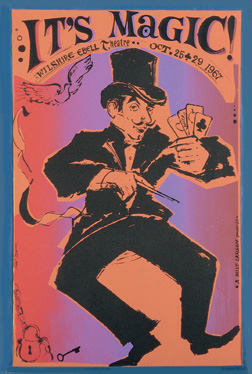 Earl Newman
|
| L.E.Gazette: I must confess to getting confused by the numbering. Sometimes there were multiple shows per year, and some years had no shows.
Milt: Which is a problem, because this isn't our 50th show. For many, many years, right up to about '95, or probably '98, we'd say the 46th edition. But then we found out we were getting confused, because we'd say we just did one of these, and that was a different show. So then we started saying the 49th annual show. So we're taking the 50th number because we started in 1956, and now it's 2006. At any rate it's our 50th year of doing the show. It's not our 50th show. This year alone, if we said edition, and each of our outlying performance arts centers would be an edition, we'd be at about our 150th edition. L.E.Gazette: The first performance was Hocus Pocus '56. When did you come up with the name It's Magic!? Milt: The very next year. Hocus Pocus '56 really sucked as a title. What can I say? I was very young, and that's the title you give something your senior year in high school. I think I was influenced by Ken Murray's Blackouts of 1946 or something, but that wasn't a hot title. It's Magic! seemed like a winning title, and we put that on the second year we did it, and it's been here ever since. L.E.Gazette: Have you trademarked the title? Milt: We basically call it a trademark. The Magic Castle is a registered trademark, but It's Magic! is a very generic title. There's Doris Day's song "It's Magic," and people have been calling shows It's Magic on and off, so we never felt it was a totally trademark-able title. Probably if we had a logo, which we do, and incidentally there should be an exclamation point on there, but we don't really worry about it. There are a couple of shows that I know of going on that are called It's Magic, but the annual It's Magic! show has always been very special, and the concept would be like trying to trademark the concept of vaudeville. Our formula has always been the same. It hasn't changed since the day we opened, and that's really a credit to a fellow named Snag Werris who was president of t he S.A.M. at that time and kind of my mentor in comedy writing. He was the head writer for Jackie Gleason and worked for all the top comics. Snag had come out of burlesque and vaudeville, and he taught me a lot about vaudeville, and the balance of vaudeville, and if you really look at the It's Magic! shows, we've never varied from the formula. We open with a silent act, what you call a flash act. You think of an act like Marvyn and Carol, a perfect opening act. And then we usually have our emcee take over, and he'd do a comedy spot. Then we'd always have a manipulative spot, whether it was a Jimmy Aubrey or Juliana Chen or whoever. Then we'd close the first act with a flashy illusion large act. We'd open the second act with a novelty act, ventriloquism or juggling work, and comedy. And then we'd close with a big illusion act. And that's the formula. We've never screwed around with the formula because it just happens to work perfectly. |
|
L.E.Gazette: As Producer, you once said you didn't mind losing a little money as long as you were promoting magic. Did that philosophy pay off in the long run?
Milt: The thing started and really never changed that much, until Terry Hill came aboard and taught me that it is nice not to lose money. [Laughter.] His business is producing. We go into a theater, and we provide the show, and they give us a check, and there's a profit for us, and we pay the acts, and that's it. In the old days, up to that point, it wasn't really important whether we made money or not. Luckily we usually broke even, and sometimes we'd make a couple of dollars, and sometimes we'd lose a couple. I've always felt that if there hadn't been an It's Magic! show, I don't think we would have done the Magic Castle. We kind of proved by doing these annual shows, and with Bill and Genii magazine and the whole thing, that there was a very, very big interest in magic in southern California. At a time in the fifties, when we started these shows, magic was really pretty dead. It was just after World War II, and it was unheard of to think of a marquee in Las Vegas having a magician on there, much less the headliner. So we kind of had to bring magic out of the doldrums, and this was a way of doing it. For the first time, when we started doing these shows, all of a sudden they are seeing first-class magic on a first-class stage. We were trying to prove a point. Bill was trying to do Genii, and I was trying this. I had made a living as a writer, and Bill had made a living as a producer at CBS, so magic was something that was inbred in both of us. There was no way that two Larsens of the Larsen family of magicians — my dad was probably the most enthusiastic magician the world has ever known, with T. Page Wright and him writing articles for Sphinx and all that, plus starting Genii — so there was no way that Bill and I, and all our friends were magicians, would not want to see magic prosper. So It's Magic! was the fuse that lit the skyrocket that started going up with magic being popular again. So we had the faith. It was only five years later, really, that we started working on the Magic Castle project. We started that in '61 even though we opened in '63. I don't think we would have had the faith in doing a project like that if it hadn't been for It's Magic! showing that people were really interested in seeing magic, and enough of them would come to the shows. Hey. If people who come to the show every year would come to see a little club! Of course we had no great intentions for the club. We thought some year we might have as many as 500 members. And take over the second floor of the old house. | 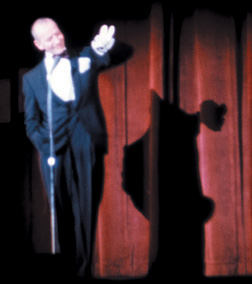 Jay Marshall
|
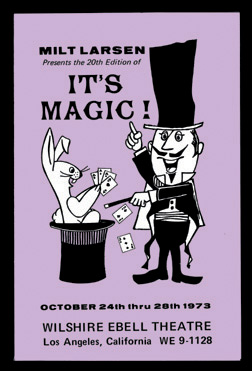 Robert LaPlaine
| L.E.Gazette: Let's discuss Directors. Did George Boston direct the first show?
Milt: I think George may have done that one. I started working for George at Abbott's when Abbott's had a store on Sunset. I was coming over after school. He was the manager of the store, so I knew George, and I'm pretty sure he would have been the director on that show. I don't think we were necessarily listing him as the director. But then he did many shows after that. Then Dick Zimmerman came aboard. L.E.Gazette: My notes have Dick Zimmerman directing a long run, doing most of the shows from Edition 13 through Edition 30. Prior to that, I have a one-time effort by Al Jansen and at least one by Gary Grayson. Milt: Al Jansen did it the year Torchy Towner was on. The reason Al did that show is that Torchy was doing the whole Fountania Dante routine, and Al kind of came aboard as the tech on it. L.E.Gazette: Following Dick Zimmerman, has Dale Hindman been your principal Director in the modern era? Milt: Yes, Dale has done it pretty much since we've been at the Alex. Since I've been with Terry Hill. L.E.Gazette: One of the things that made It's Magic! special in the early years was your insistence on an orchestra. I recall the pride with which Bill used to discuss them into the eighties. There were names of such orchestra leaders as Ray Henderson, Ivan Ditmars, Frankie Ortega, Robin Frost, George Annis, Jerry Rosen, and Bill Hitchcock. Milt: We had them up to halfway through the shows at the Variety Arts. I'm trying to think of the first show without an orchestra. We played normally with an eight-piece orchestra, which is a pretty good size orchestra for that kind of house. I loved and still do the idea of a live orchestra. If I had my way, every theater would have a hydraulic pit, and you'd have a 60-piece orchestra come up and play the overture. And I'd never use them again. But the changing of what happened with magic is that we got to the point that we were paying the orchestra more than we were paying the acts. Because, you know, with the union prices and everything. At one point I tried to cut the size of the orchestra, and this was at the Variety Arts. And they said, "No, you've been doing eight pieces in the theater, therefore you have to have eight pieces." I said, "How about six?" And they didn't want to do that. So I said, "All these magicians have tracks that they use, and half of the shows are played on tape anyway. A lot of magicians today don't even have orchestration." But this was at a very critical time with the union. They said you can play with one musician or a full band, but that's it. So I said, "Okay, let's play it with one musician." So we put a drum in the pit, because I like rim shots. So at that time I had kind of a little run-in with the union, because they thought I was unfair to them because I took the band out of the pit. But we really had no reason to have one, because all they were doing was playing the overture and the exit march. People like Shimada would come in with a Japanese symphony playing his music, and technically it sounded great. The union kind of shot themselves in the foot by allowing tracks as all the Vegas shows do. So at any rate that's when we stopped using the live bands. But we had live bands right up until the eighties. L.E.Gazette: Another feature that characterized the It's Magic! shows was terrific Art Direction. Milt: Basically John Shrum did all the shows up until the time he died. After that, Joe Hossman has been doing our shows. But we haven't been particularly listing an Art Director. L.E.Gazette: I show NBC Art Director John Shrum first joining It's Magic! in 1961, coming to you from Truth or Consequences. Milt: I started doing Truth or Consequences in 1956. Actually the first show was December 31 of '56, so it's kind of a cheat to say that. And John Shrum was the set designer on Truth or Consequences. People don't realize that on that show we had costumes and sets for a game show. It's crazy. |
| L.E.Gazette: And later, of course, John Shrum went to work for The Tonight Show at NBC, for Johnny Carson.
Milt: Johnny loved us. So John had a production number over at NBC, the Shrum 1000. When he would do something he knew was going to be on It's Magic!, he would put it under the Shrum 1000 production number, and Johnny and his producers pretty much knew that was being done. John didn't try to sneak it without them knowing it, because that would have been suicide for him, so they kind of knew when they had a background that had Tahiti in it and used behind some torch singer, conceivably it was stretching a point, but they were very nice about it. John also had access to all the NBC warehouses, and he knew what was in the NBC stock. So many times we could call on John to bring over sets that had been used on something else, and we paid a very reasonable rental, and they were happy and we were happy. But he was marvelous at doing it. John had a great way of doing the shows too, which was, he always felt if you went out humming the scenery, it was a lousy show. He stuck to that. He said when the scenery starts upstaging the performer, it's a lousy art director. He would always make sure that, if it was, let's say, just a single manipulator, the scenery would focus on the performer. But you wouldn't see the scenery. You know it's there, but the performer would be in the lights, with a semblance of scenery. He was brilliant. That's what he did. L.E.Gazette: And it was John Shrum who first started using a beaded curtain to hide threads? Dick Zimmerman told me you could light that backdrop just about any way you wanted, and you could not see the threads for an "Asrah." Milt: I think he was the first one who started using mylar strips. Everyone said he's crazy, it's got to be black threads against black paint. He said, "No, they're never going to see the threads in my set." L.E.Gazette: In 1959, you first turned the corner financially, for which you've often thanked the Carrolls Agency, especially Shirley Carroll. Milt: Shirley was brilliant. The history of Norman and Shirley ... Norman was a ringmaster for Ringling Brothers when they were on the west coast. They handled all the publicity for Ringling Brothers on the west coast. You'll notice you're always reading about Ringling Brothers. He loved magic, and unfortunately he passed away very shortly into the run, so then Shirley took over the Carrolls Agency. Her philosophy was that you sold the show as an event, as something special. It was not just a magic show, this was the magic show. She would go out and get publicity, and she did the same thing for the Castle. She'd say, "I'm going to make you famous in all the foreign countries before I work on the people across the street. If the people across the street hear that their friends want to see the show, they're going to come and see your show." Then they have to take them to it. But she would do things ... I think one of the best promotions, as an example I can remember, is we always did the show around Halloween. One year she sold the Hughes Markets the idea of putting masks on their paper bags at the market, and the masks had a face on them. They had four or five different cartoon faces. You would punch out the eyes and put them over your head, and it would be a Halloween mask. And on the back of the thing there was a tear-off coupon, courtesy of Hughes Markets, two dollars off the ticket price. Well the kids, in the first place we put out like 200,000 bags, which nothing for a market, just locally. And kids were going around town with these bags over their heads, and taking the coupons, and we just sold so many that year. But she would do things like that. She always told me you don't try to get things in the Calendar section of the Times, because you've got the movie studios with all the clout in the world, and all the stars. She'd say we go for the city side. We go for the first page of the second section, which is "What are you doing for the underprivileged children?" We'd take our magicians to a hospital and we'd end up on the first page of the LA Times with a six-column spread, where you'd get only an inch and a half in the Calendar because you're fighting a movie. But that was the way she thought. She was just a brilliant, brilliant lady. She's still around. She retired in Laguna. Her life these days is doting over her grandchildren. | 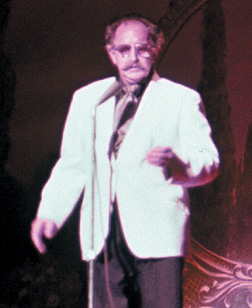 Clarke Crandall
|
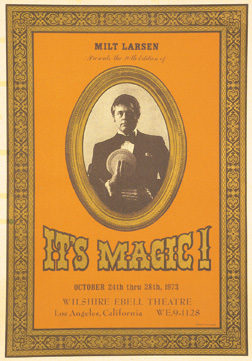 Robert LaPlaine
| L.E.Gazette: One of the most enticing things about It's Magic! over the years has been your poster art, often reproduced on the programs.
Milt: Most of the cover art is from posters of the various shows. This one [featuring a framed photo of Mark Wilson] was Bob Laplaine. That [a caricature of a smiling magician in a top hat which looks to your humble interviewer like Milt, but others see it as more of a composite of Jay Ose and Stan Laurel] was the very first poster, in '66. At that time Earl Newman was a pretty respectable young artist, and Shirley Carroll again knew him from the Ringling Brothers days. So he did this one because she thought it would be a good idea. This was silk screened. The next several [looking over a lovely spread of poster memories] ... this was Earl Newman ... then Bob Laplaine did several. This was Earl Newman who came back. The fellow who's doing this year's is Michael Bayouth. Christine Zamiara did a whole series. This is Bayouth. Basically there's only about six artists who did all the posters. [The professional artists include Earl Newman, Bob Laplaine, Christine Zamiara, Michael Bayouth, Paul Butler, and Luis Solorzano.] They're very different. The only one of all of these, Arlene did that one. That was a year that we decided not to do a poster. And she said, "We've got to have a poster." I said, "We're not going to do a poster." It was kind of in the waning days, and I was having financial problems downtown, and so she said, "You're going to have a poster." So that was her poster. The poster this year, a preview of it ... L.E.Gazette: For those of us living in the Midwest in the golden age of It's Magic!, we could count on Halloween being the time of year we could see magicians on Johnny Carson. We got to see your acts on television. And what publicity for the show! Milt: Well, essentially, the big "in" there was of course John Shrum, who was senior Art Director. Johnny loved magic in the first place, and he knew that we had the integrity that if we said there was an act would be a hit on the show, we'd never give him a dud. In the first place, on all the It's Magic! shows, we never booked an act that we thought was a dud act. The question was whether it would be a good act for his show. And both Bill and I felt that we knew what would be good for his show. So any time we called Johnny, we'd say, "I think we've got an act on the show that you'd be able to use," and he would usually send his head booker down, Jim McCauley, to take a look at the act and then, if it was what we said it would be, they would make sure they bumped somebody else out to put the act on, because he knew the value of a plug on the Carson show. And Johnny himself, if he said he wanted to have an act on the show, it didn't much matter what anyone else said. So thanks to Johnny, Lance Burton and people like that got their big shot in the arm. All year, if we called the show and said we think we've got somebody good for you, we never took advantage of it. If we weren't 100 percent sure of an act, we'd never bother them, because they get so many requests. But that "in," mainly, is another credit to John Shrum, because he had the back door open for us. |
| L.E.Gazette: Obviously, a lot of things have gone right with It's Magic! over the years. Let's talk about a few things that didn't go quite so right. I recall being greatly amused when Bill first wrote about Randi, "The Man No Jail Can Hold," from the 1959 Edition. There was a challenge handcuff escape, and the audience was invited to bring up handcuffs. "Unfortunately," according to Bill, "someone did and it wasn't a plant as we all thought at the time. Twenty minutes later the Producers blew the whistle and the show went on, somewhat dulled by our Eastern guest."
Milt: Yes, that was very unfortunate. As luck would have it, he had trouble. He had a challenge handcuff thing and couldn't get out of the handcuffs. George Boston was the director at that time and he arbitrarily just dropped the curtain and went to the intermission. I think Randi came back after the intermission and did a gag thing. But he was very embarrassed. He did a couple of things and was going to close with getting out of the handcuffs, and he didn't. That was a pretty funny one. L.E.Gazette: How about the show with Bob Towner as Professor Robert Harlan? Milt: Oh, that was a marvelous thing. Everything was going well. You know the dancing Fountania act. I saw Dante, not in his heyday, but not in his last years either, when he was still a great, great magician. Both Bill and I thought Dante was the greatest magician we'd ever seen, because he looked like a magician and sounded like a magician. He did his revue with great acts. The Fountania was a major stage production with beautiful Japanese costumes. We had the costumes and the set, a beautiful applique drop from the Dante show. Al Jansen at the time had provided all that. And Torchy Towner — Robert Towner — had the rights to do it, and Al was helping him with it. Everything was perfect. A beautiful, beautiful act. The act is almost like a dance thing, with Japanese ladies and a magician in a Japanese kimono. He'd take a little water from the lawn and put it on a fan, and then take it from the fan and put it over there, and it would be spurting water, and it was a dancing waters type thing. When I saw Dante do it originally it was incredible. And Torchy — I keep calling him Torchy, but I shouldn't do it because he hates that name — Bob Towner, was doing a beautiful version of the act, and everything was really fine, right up to pretty much the end. The way the act worked, and I don't think we have to worry because it is The Little Egypt Gazette and we don't have to worry about telling a few secrets, but the way it works is they actually hitched the water to a fire hydrant outside the theater, and the control on it was a great drum-looking device. This was the original equipment that Dante used in the twenties and thirties. The way it worked is that Al Jansen or the assistant stood on kind of a treadle device, and by lowering himself up and down on this treadle would create the valve that would keep the pressure going. If you think about it, one little spout of water coming from a four-inch fire hydrant is difficult to deal with. Then as you got to 20 assistants with a lot of water going, you had to feed more water into it. So they had this regulator on the fire hydrant, so it wasn't four inches of water, but it was a lot of water, and the regulator was Al Jansen on the treadle. Well, Al was a little along in years by that time, and he slipped off the treadle. I'm getting a little ahead. The climax of the act is that you are doing all this stuff, and Towner would go over with a cocoanut shell to this kind of set piece that was like a waterfall. The way it's supposed to work is that you put the water in the thing and turn the cocoanut shell up and put it down over it, and a stream of water would come up underneath the cocoanut shell and then cause like an umbrella effect, so it looked like a lot of water coming out. Then you lift up the cocoanut shell and it's spouting water, and there's a big waterfall, and that was the end of the act. But what happened that night is Al fell off the treadle. Which meant that all the pressure is coming into this one spout coming up into the thing. And, I don't know how you can write this, but I can show you. Here's Torchy. And here's the cocoanut shell. And he puts his other hand on top of his hand, holding this thing down. Now, there's nobody controlling the pressure, including the other people on stage too, and so finally he can't hold it anymore and he takes his hands away, and a fountain of water goes up, and everybody knows when you hit hot light bulbs with cold water, there is a definite reaction there, so in those days — this was back in the sixties — they still had the old borders with just light bulbs, and so as the water's going up hitting the borders, glass is showering down, little explosions are going off, and ... [reduced to laughter]. Bob Barker was in the audience that night and said that was the funniest act I've ever seen in my life. I don't think Bob Towner thought it was terribly funny, but it was spectacular. We ended up having to pay I think a couple of hundred dollars for repairing the theater after that. But it was a pretty funny, unforgettable thing. And in those days we were doing a two-night show, and I think this was the second night. Anyway. Poor Bob, I felt so sorry for him. |
|
| L.E.Gazette: Dick Zimmerman told me one funny story that you didn't know. He said, "I was backstage as Director, and Milt never was backstage. For many years Jerry Rosen led the orchestra, and he was a very fine orchestra leader, and he had very good musicians. He put together a very nice overture for the show, a medley of 'It's Magic' and 'That Old Black Magic' and whatnot, and the way we had it written was, as soon as the orchestra finished, they would go into a timpani roll, and a backstage voiceover, that was usually me, would say, 'Ladies and gentlemen, welcome to Milt Larsen's 15th annual production of It's Magic!, starring ...' And then we would mention the first act, and then there would be another little roll, and we would go through the whole list of acts, and finally 'Jerry Rosen and the It's Magic! Orchestra.' So anyway, that worked out very well. The only problem is that it was very common that the sound man would not have the backstage mike on. So I would be off on stage right and saying, 'Starring in this ...' and you would hear nothing. Meanwhile there was this timp roll going, waiting for the voiceover. It turned out that after a few years the orchestra members started making book on whether or not the voice would come on or not. We finally got pretty good, and the people who didn't think it would work lost some money. But that was pretty funny. On the first night that was always the point that everyone was talking about." |
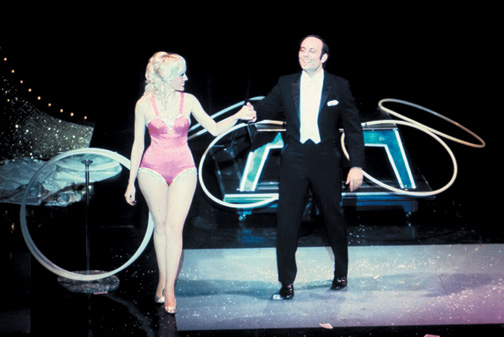 Dick and Diana Zimmerman |
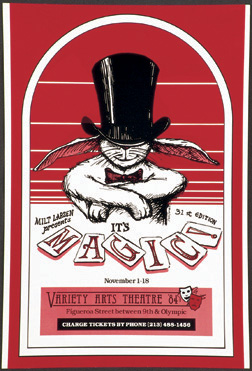 Earl Newman
|
Dick also mentioned that I should ask you about the night you thought Chen Kai was going to burn the theater down. Milt: Oh, yes. That was pretty funny. Chen Kai was doing basically a fire bowl. He was producing mouth coils. He was doing a very pretty act, with a lot of manipulation. At one point he's doing a serpentine out of a bowl, and then the bowl catches fire, and a dove flew out of the bowl — it was very pretty. What he didn't notice was that one of the pieces of serpentine lit. It was like a little fuse. And he came directly from Mexico, where they don't think about fire retardant paper as much as we do up here. Nobody thought to ask him. So the picture on this one is that Chen Kai is in front of the oleo drop, downstage, and produces the thing. Now the audience is seeing this little bit of fire going down, and he's standing in a pile of serpentine, so now it's like Joan of Arc. Because the audience knows when that fire gets down there, and he's standing in all that stuff, that they're going to see Joan of Arc as a Mexican magician burned at the stake. So there's a certain amount of anticipation in the audience, wondering whether to run for the exits. At that time Dick Zimmerman was stage manager. So Chen Kai doesn't realize he's about to go up in flames. And so the picture from the audience is you see the curtain right in back of him being picked up by a hand, and the CO2 fire extinguisher going swoooosh. [Laughter.] And there's a great amount of applause from the audience because they figure now they can stay and see the show because we're not going to burn it down. I don't think Chen Kai ever knew why he got such a reaction on his fire bowl. L.E.Gazette: I've seen a photo of Chen Kai doing that act. It could have been spectacular. Were there any similar mishaps? Milt: There was one with John Daniel. John was on twice, the first time on the sixth edition, and then we brought him back in 1963. The first around he did a great act, and the second time was great too. The first time he did the Chefalo kitchen scene, and it was the first time the Alan Wakeling thin sawing had ever been seen by anybody. And it was just a standing ovation. It just wouldn't stop because nobody had ever seen a sawing that didn't have a box you could put two elephants in. And all of a sudden he's doing this thin sawing. It wiped them out. Anyway, that isn't the show we're talking about. The second time around John came in and he was previewing a show he wanted to sell in Vegas, and in fact did. It was his Shazam show. The whole thing was based on scenes of Hades. We got a bit of a knock on the show because It's Magic! had always been a family show. Always, to this day, you can bring your kids and grandkids. Never a question, and we never questioned John in rehearsals too much, but by the time he got on stage with it, it was very Vegas. Vegas being that the ladies were almost dressed for the occasion. Nothing wrong, but it was just a little adult for our audience. And then he was chopping up people and maiming them and not bringing them back, and so it was a little heavy for the kids. But that's beside the point. The fact of the matter was this great production number in Hades. He opened the second half. In fact I think he did the entire second half of the show. Here's the thing. The opening number is supposed to be Hades, and he had fog. Theatrical fog, with red lights and stuff, so it looked great, fantastic. So they turned on the fog, and the backstage filled up with fog. And when the curtain went up, all the people in the audience saw was a sheet of white. We all know that fog is heavier than air, and it's supposed to sit on the floor, but they turned it on a little early, so the whole area was filling up with this CO2 smoke. So when the curtain went up, all they saw was this big sheet of fog, and then, the fog had no place to go except out into the audience and into the orchestra pit. So if you can imagine the orchestra, and at that time we had our full orchestra, eight or ten pieces, with the "Orpheous," a very heavy piece, and the fog now is coming into the orchestra pit, so the musicians can't see the music, so the musicians are playing the wrong notes because they can't see, and the audience is coughing, and they're afraid of the whole thing. It cleared, because the theater had great ventilators, but, for that wonderful moment, the curtain went up and the orchestra was playing all these sour notes and the actors on stage were kind of waiting to see where their spots were, and it was very, very funny. |
| L.E.Gazette: Obviously some mishaps weren't so funny. I believe it was the 22nd edition, in 1975, where you had to make numerous last-minute substitutions, for such reasons as Harold Taylor getting stopped by immigration and Johnny Thompson landing an important Flamingo contract.
Milt: Those things happen, particularly when you're trying to put together a show, if you have immigration problems, or if you're bringing animals in. Harold Taylor, you know, made the mistake of telling somebody in Canada he was going to go down and work on a show. And they said, "No, you're not, you're going back to England." And he had just stopped by to see a friend in Canada. It didn't occur to him that he didn't have a work permit. A lot of our people we consider honored guests, and they kind of looked the other way as we did the show. But in that case they didn't. So a lot of those things went on in the course of the show. You could probably do several books on the little problems. L.E.Gazette: A more serious problem for that show was the unexpected death of Omar Pasha, whom you replaced with Ralph Adams. But I don't understand: I've seen Omar Pasha's act since then. Milt: The original Omar Pasha. There are different Omar Pashas. The one who is doing the act now bought the act from another Omar Pasha. That act's been going on for years. But at one point we had Omar Pasha booked, and he died just shortly before the show. That was the original Omar Pasha. L.E.Gazette: Let's talk about some of the acts. Over the years, It's Magic! has given a boost to some magicians, and more established magicians have given a boost to It's Magic!. You have often mentioned your debt to John Calvert for appearing on your second show. Milt: Oh, yes, that was a great show. As a matter of fact I just talked to John. He's going to be on our 50th anniversary tv special, assuming things go as planned. What is John now, 92 or 93? At the time I called him for that show, he was a very well-known star and personality. They were B pictures, but he was The Falcon. When I called him and he said he'd do it, I was just flabbergasted. I remember I was on a pay phone in the NBC hallway at the time, doing Truth or Consequences, and said, "I'd love to have you on the show." He said, "You know, I knew your father, and I loved your father. And I know your brother and the family. But you can't afford me." I said, "I know that, John." So he says, "I might as well do it for nothing." He tells that story better than I do. I think he was one of those people ... the fact that people like John Calvert would do the show meant that [other] people would then have respect for the show and do it rather than [treating us as] a couple of kids down the block that are putting together a Mickey and Judy show. L.E.Gazette: Conversely, It's Magic! has helped launch such "youngsters" as Lance Burton, Harry Anderson, Shimada, Dirk Arthur, Ed Alonzo, Mark Kalin, Darren Romeo, Goldfinger and Dove, and the Pendragons. Tell me about Lance. His first appearance on the show was in 1981. Milt: Naturally. Lance was there on his 21st birthday. I still remember the time when he came up. I was up at the fourth floor W.C. Fields bar at the time, and said, "When Lance comes in, I need to see him. As soon as he comes in." And I said, "Lance, would it be possible — I know it's really short notice — but tomorrow could you be on The Tonight Show? And he said, "What's involved?" I said, "You've got to be at Burbank at like five o'clock. Rehearsal's like one o'clock. They tape the show, so you would be back here in time to go on." And about halfway through the conversation, he said, "Is that the Johnny Carson show?" [Laughter.] Everything was going okay right up to that point. "Do you mean the Johnny Carson show? Is that the Johnny Carson show?" He just couldn't get over it. So then he did it of course, and Carson absolutely loved him. Carson always had a thing, a little movement he would make, kind of like a thumbs up, a way he would hold his hands after an act to indicate whether the act was going to be back or should never be seen in show business again. It was just a little quirk that he had, but everybody knew it, and when Lance was on, he held his hand in that way. He'll be back. And of course he was on like nine times. And Lance has always credited that as his big break in show business. We like to think that. He's a great guy. He came back and did the show after he had his own theater. He closed his show in Vegas long enough to come back and do an It's Magic!, and that was just totally a thank you for giving him his break, because he lost money doing the show. Everybody loses money doing the show, what am I saying? But he lost a lot of money doing the show. | 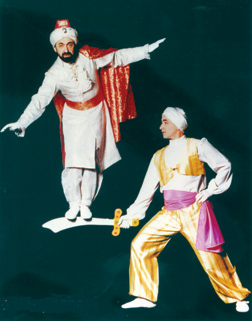 Omar Pasha
|
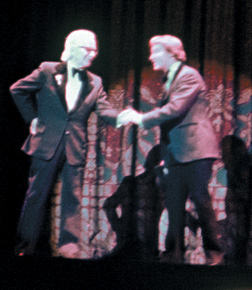 Dai Vernon and Mark Kalin
| L.E.Gazette: The show I mentioned earlier, when you had to replace Harold Taylor and Johnny Thompson and Omar Pasha, turned out to be one of the great shows. It was the show in which Shimada first introduced his dragon illusion, and the show that juxtaposed Dai Vernon with Mark Kalin.
Milt: Shimada, we kind of brought him up from Mexico the first time, and he was very popular. I think he did the show more times than anybody. And Mark Kalin was at that time, and I guess still would be, the youngest we ever had. That was a great act. We paired him with Dai Vernon. It was magic old and new. Dai did the classic Linking Rings, and then he introduced Mark Kalin, who did the linking billiard triangles. It was a dynamite act, because everybody loved Dai, and to have him introduce a fifteen-year-old kid ... L.E.Gazette: I've often been intrigued by something Bill wrote about an earlier Dai Vernon appearance. He said, "Working in one, Dai charmed the very dickens out of the audience. So professional." Can you elaborate? Milt: Well, Dai was a marvelous, marvelous performer. He was just terribly smooth. He looked like a magician and he talked like a magician and he charmed the pants off the audience. He did all the above, and at that time, he would have been in his sixties, so he wasn't the grand old man of magic. He was just a very well-known performer from the East. L.E.Gazette: While we're on Dai Vernon, he was of course part of your first instance of presenting the Classics of Magic, using three performers. Vernon did his Linking Rings, Frakson did his Cigarettes, and Alan Wakeling did his Billiard Balls. As Bill wrote it up in Genii, "Framed in a stage within a stage each performer appeared out of black in a bright spot and did his thing. Each was flawless. I expect to see other shows copy this idea but they will never capture the greatness of Vernon, Wakeling, and Frakson unless they can get Vernon, Wakeling, and Frakson." Plus Genii ran some great Pete Biro photos of the acts. Whose idea was this? Milt: I suppose it was basically my idea, because I always tried to find, like magic old and new, some kind of a way we could combine things. We had those three things going for us. In the first place, Bill and I always used to work very closely together on everything, so we never separated who had what idea. We were probably sitting there at the bar one night, going, "This is a great idea. To bring three people together." L.E.Gazette: The following year you visited the Classics format again with Bill Larsen, John Daniel, and Alan Wakeling. What did they perform? Milt: What we did on that Classics was ... Bill did the Lazy Magician, Dante's Lazy Magician. John did the Thin Sawing, and I think Wakeling did the Gorilla (Crushing a Girl). So those were three classic illusions and the other was three classic manipulators. L.E.Gazette: Then, in 1973, it was Joe Cossari with his Card Fans, Charlie Miller with his Rice bowls, and Peter Pit with the Dancing Cane. Milt: Yes, so it was just a formula that started working for us. It still would if we could find three people who were that good. L.E.Gazette: Getting back to those in the dawns of and the twilights of their careers ... Milt: We've had Harry Anderson. His first major stage appearance was on It's Magic!. The list goes on. Of course we had some of the last appearances of people like Chang and Harry Blackstone, Sr.. L.E.Gazette: Blackstone was on the same show as a young Billy McComb, about whom Bill wrote, "[Billy McComb] is without doubt one of the most charming people in magic. To meet him is to like him and this same feeling immediately comes across the footlights when he is performing. A real winner, this one." Did Billy emcee that show? Milt: I believe it was Billy's first trip to America. Frank Herman would have emceed, so Billy would have just done his magic act. Clifford Guest was the ventriloquist, and Boxley and Marie would have opened. And Harry, Sr., that was the year at the Pasadena Civic Center. The interesting thing about that show was the union, and we had always played with an eight-piece band. Because we were at the Pasadena Civic Center, they had a 21-person minimum. So I went to the union and said, "Hey, magicians. Twenty-one people are fine for Aida, but it doesn't work too well for magicians who don't even have 21 charts to their name." And they were adamant about if you're going to play the Pasadena Civic Auditorium — we had 2400 seats or so — then we've got to have 21 men in the pit, so I did. We had 21 union musicians. We knew, Ollie and I, that because of the enormous expense of the stage hands, because they also had a whole building full of stage hands, and the cost of the orchestra, that if we went one minute over time that, even though we had a full house, we knew we'd lose our tails. At any rate, what happened on that show is everything was going fine, the show was running a little long, and then Harry, Sr., got on. And this was one of the last shows he ever did, the last major stage shows. And he was just great. He did the big stuff, then he did the light bulb. But the thread broke on the light bulb, and he covered beautifully, went back and got himself another light bulb (and another thread, as we all know) and came out and did it. But at that point, Ollie and I were in the back of the auditorium watching the clock. And we knew, there was no way in God's little green earth that we were going to get off by 11 o'clock. Eleven o'clock was the key to the thing. If we could get the last note of the band out by 11 o'clock, it was a difference of several thousand dollars. Anyway, he didn't. Unlike the Amazing Randi time, where we actually closed the curtain on Randi, you cannot close the curtain on Harry Blackstone on his final performance of his career. That was a great moment. That was the first and only time we did it at that theater, because it was too expensive. |
| L.E.Gazette: For all the great acts you have had on It's Magic!, I note a few who never appeared. Ballantine introduced another act on one occasion, but I don't believe he ever performed his classic routine.
Milt: No, he never did it. We invited him many times, but for one reason or another he wasn't available at the time. He did some shows for us, variety shows, at the Variety Arts Center, but he was never on It's Magic!. L.E.Gazette: Another, whom Bill mentioned as being booked about a year in advance but who didn't make it, was Steve Martin. Milt: Oh, yes. Steve was never on It's Magic!, but he did do his Flydini at the Castle. Ernie Kovacs was on the show, one of our very early ones. L.E.Gazette: He did a bit with a guillotine? Milt: There again, because I mentioned Snag Werris earlier. Ernie had just started at NBC and was fairly unknown. He had his own show, but he wasn't the leader he became. One of my favorite people, one of the most inventive comics in the history of television, but at that time he was just starting. At any rate, Snag knew him, he was doing a show over at NBC, and Ernie loved magic, and he just asked him. He said, "Well, I don't know what I'd do," and Snag said here's what you'll do. So he did the classic Lester Lake guillotine. There's a wonderful picture of my mother and Ernie Kovacs. Anyhow, the lady in the guillotine is my mother. So Ernie just did the classic routine with the head chopper, and he also emceed the show that year. L.E.Gazette: Speaking of your mother, let's talk about appearances by the Larsen family on the show. Obviously the family member who has appeared on more It's Magic! shows than anyone is Irene Larsen, who has assisted many times. But first there was Geraldine Larsen, who was on the very first show. What did she do? Milt: She did her classic Magic Lady act, the act that we used to do as the Larsen family of magicians. We had one spot in the show when she was in the hoop skirts and doing a very beautiful act — feathers from the foulard — a very pretty act. That was the act she did on the show. L.E.Gazette: You've mentioned that Bill did Dante's Lazy Magician as one of the Classics of Magic, on the show in 1971. But Bill has made many appearances, starting with the Third edition of the show. What did he do on that occasion? Milt: Bill always did illusions. He did what was then his basic stage act. He did the Sword Box, and Bill was a very good illusionist. He had done, to that point, P.C.A.M. shows and things. Later he did Memories of Dante. L.E.Gazette: I attended his Dante performance, in the 24th edition, in 1977. It was wonderful. In Genii, Will Hutchins was quoted as calling Dante "the Barrymore of magicians," and he praised Bill's performance as "eerie, almost scary." Milt: Bill loved Dante, and so did I. By that time he was married to Irene, so she was assisting on that one. L.E.Gazette: Bill's most elaborate illusion show was probably his 1969 appearance, which included Aerial Fishing in a barnyard scene with Irene dressed as Daisy May, a magic shop scene borrowed from Dante's Magician's Rehearsal, a floating and vanishing piano, and a sub trunk which climaxed with a guest celebrity appearing from the box, followed by a spot hitting Bill who was leading the band in the pit. As Bill wrote it up himself, "It was GREAT! (He's modest too.)" What intrigued me most about Bill's write-up was the opening number, which featured large playing cards in an Alice in Wonderland scene. Milt: We did that one just for It's Magic!. What happened on that one is that NBC had done Alice in Wonderland as a tv special. So we were able to get the costumes and scenery from the show. Basically we used those as stage dressing. L.E.Gazette: Although I don't see Milt Larsen's name in these fifty years of act listings, I have seen a photo of you performing your Carpenter act. Did you manage to ever appear on your own show? Milt: I did it one time. The one time I did it was in Santa Barbara, on a show at the Lobero. That's why it doesn't show up in the Hollywood shows. That was because my mother had never seen the act. She was 89 or 90 at that point, and I said, "Okay, we're going to do one of the It's Magic!s at the Lobero in Santa Barbara, and I'm going to book myself on that show to do that." This year we are as far away as Mesa and Tucson, Arizona. And we have one in October up in Washington. If we start listing all the acts in all those other shows it will be difficult. And yet you're going to have people say, you did this whole thing on It's Magic!. I was on It's Magic!. Yes, but you weren't in Hollywood. And we did some shows when we had the Variety Arts where we weren't in the big theater, so therefore I didn't count those as annual flagship shows. |
|
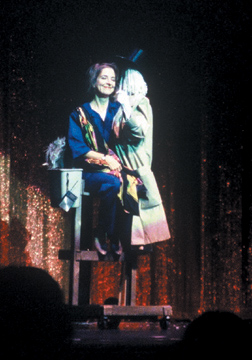 Tina Lenert and Mopman
| L.E.Gazette: During the first 30 years or so of It's Magic!, I notice very few women. Besides your mother on the first show, I think only Diana Zimmerman and Frances Willard received billing. Then, in the nineties, there was an explosion, with Sherry Lucas, Connie Boyd, Juliana Chen, Tina Lenert, Mystina, and Princess Tenko as a closing act. Comments?
Milt: Two things happened there. In the first place, women started doing more magic. In the early days, there was my mother and Dell O'Dell, and that was about it. They both had their TV shows. But there were very few single ladies doing magic. There were ladies doing magic, but it was normally duos. Chop Chop and Charlene, Tenkai and Okino, and blah blah blah. Then in the nineties, women started doing their own acts. We always try, every show these days, we try to put a lady magician in just for balance. You don't want all guys. It also used to be that the acts in the earlier days would have more pretty assistants, and now you find more single performers, so you've got to put some ladies in there someplace. L.E.Gazette: So we're coming up on 50 years of this magic show. A lot of performers have come and gone in that time. A lot of time has gone by. Milt: There's the Magic Company. The Magic Company were two guys and two girls. A really good act. They were all pretty much teenagers. They did illusions, a very sharp act, and they were very young people. At that time we still had the orchestra, and we were at orchestra rehearsal at a musician's union where we used to rehearse the orchestra the day before the show. So they came up, all four of them, and said, "Mr. Larsen, we just to tell you how absolutely thrilled we are to be on your show." And I said, "That's really very nice, so nice of you to say that." And they said, "Yes, we were talking, and all of us got our interest in magic because of your show." And I said, "That's really nice of you to say it." "We were talking about it. We saw your show. And Mike was five years old, Susie was four years old, and ..." I said, well that's good, because now they're teenagers. Then, they were on our 28th Edition. To make matters worse, they said, "And we all remember it because it was your 20th anniversary show." For the first time in my life I felt like the oldest producer in the world. There are many wonderful young people in magic, but they were barely out of the cradle when they remembered my anniversary. |
 The Magic Company |
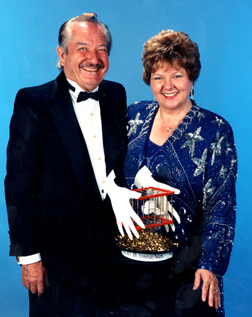 Milt and Arlene Larsen
|
L.E.Gazette: What are your plans for the 50th anniversary? Milt: Well, the 50th, we're doing a number of shows in the outlying theaters. But our Hollywood show is going to be the biggest show we've ever had, and it's going to be at the Kodak, where the Academy Awards are, just down the street from the Magic Castle. Brother Bill and I are being honored with a star on Hollywood Boulevard on the 15th of September. On the 19th we're doing a show at the Kodak. We're putting together all the stars of magic, most of them having been on It's Magic!. So far we have committed to being there just about everybody in magic that we can think of. It goes down the line — Siegfried and Roy, Lance Burton, you name them, we've got them. And that's going to be televised. David Salzman, who has produced Kennedy Center and Mad TV on Fox, is producing it along with Terry and I, and Larry Wilker is with the Kodak Theater, so it's basically in cooperation with the Kodak. So it's going to be a really marvelous show, and that's going to be a show that will be open to the public, but parts of it will be televised that will be the superstars of magic. So that's going to be our big kazoo in this year. Hopefully we're going to have a whole series of little events around that. So from the 15th to 19th of September. L.E.Gazette: Of all the acts you've ever showcased, what would be your Dream Show for It's Magic!? Milt: Well, I think you're going to see it on the 19th of September. John Calvert has already agreed to be on it. What I'd like to do is recreate the idea of magic old and new. And conceivably having a short clip of Mark Kalin with Dai Vernon, just a real short thing of the youngest magician to ever appear and the oldest. And we could do that today. We have John Calvert, who happens to be the oldest, and then we have Chase, from Texas, who is I think only 18 years old doing a big illusion act. So he could represent the young people. [Ed. note: This interview was conducted in February, and the Kodak show took place in September. The lineup changed somewhat over the intervening months, but we found it amusing that John Calvert couldn't make the show because he was WORKING in Singapore.] But going down the list of people we want on that show, the ones who are living, there are some marvelous acts who won't be the headliners we need to sell the show. The Dream Show would have to be a very long show, but my Dream Show would be to do every act that's ever been on the show end to end. It would be a long show. You're talking about almost 50 years, and doing basically a seven-act show every year, and multiples of that, that's like 365 magicians. L.E.Gazette: That sounds like a year at the Magic Castle. Milt: Magicians at the Castle, the members, are so spoiled. They see seven magicians a week, they can come any time they want, and they don't have to pay to get in. So you give them a great show once a year, and seven acts, and it could be the second coming of Christ, and they might not go to see it. But the public is a different story. The public can't come in to see the Castle every night, plus we have a moderately small stage. So it's a big difference. So once a year it's kind of the cherry on top of the sundae for people who want to see that kind of magic. If you come to Vegas, you can see seven acts like that, but at an average of 50 dollars a pop it would be a pretty expensive show. L.E.Gazette: Fifty years of magic shows! What is the fun in all this for Milt Larsen? Milt: It kind of goes back to the thing of if you're born into a world of magic, and all your friends are magicians, and the love of magic is in the entire family, if you can do something to entertain people with magic — that's what I'm doing with the silly carpenter act or whether I'm producing a show — it is really my life. I love it. I love writing. I consider myself an unemployed writer, but producing is so challenging, so wonderful, whether you win or lose. It's still like the horses are at the gate, and when the gate lifts they are at the finish line or not, but it's a hell of a race. I've always enjoyed it. Terry Hill has been a great partner with me and he shares the excitement of doing it. Bill was unbelievable in putting up with what his brother used to do. I've always just been very happy, so producing is a great thing to do. Right now we're working on a musical with Dick Sherman, and that's a project that we hope to see happen in the next year, and we constantly talk about shows and things, so it's a part of life. We used to say a wonderful thing about me, about It's Magic! and the Castle and our relationship. Locally, in the Los Angeles area, it would be my name over the title. But internationally, because of Genii magazine, I would be Bill's brother, and in town Bill would be my brother. It was just whoever had their name over the title. But at any rate Bill would always say about me, "Milt is one of those people who gets a snowball at the bottom of the hill, and he starts rolling it up the hill. Nobody pays much attention to him. He's just rolling this big snowball, and it gets bigger and bigger and bigger as he's rolling it up the hill. Then he gets it to the top of the hill, and he's done that, and it's a great accomplishment, and with that he pushes it over the side of the hill, and it comes crashing down, wiping out the towns and the villages and causing avalanches. So I'm the brother that goes down, stops all the avalanches, and puts the cities together, and assures them that Milt didn't mean to get that snowball and wipe out your family, and about that time we all look up, and there's Milt at the top of the hill with another snowball." That's about the way it is. Why do you climb the mountain? Because it's there. |
Photos courtesy of Milt Larsen.
Back to The Little Egypt Gazette.
Back to Little Egypt Magic.
Copyright© 2007 by Steve Bryant